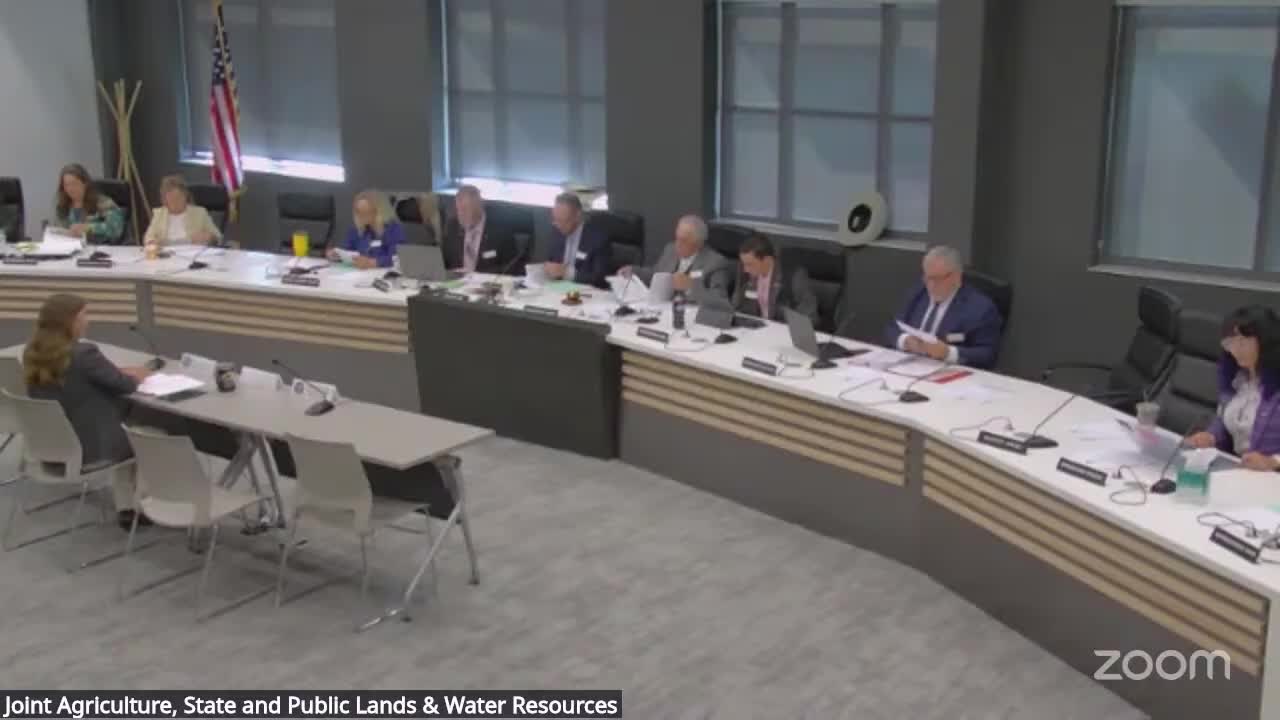Wyoming Weed and Pest Council warns of federal funding volatility, outlines cheatgrass and post‑fire priorities
August 28, 2025 | Agriculture, State and Public Lands & Water Resources, Joint & Standing, Committees, Legislative, Wyoming
This article was created by AI summarizing key points discussed. AI makes mistakes, so for full details and context, please refer to the video of the full meeting. Please report any errors so we can fix them. Report an error »

Lindsay Woodward, the Weed and Pest coordinator for Wyoming, briefed the Joint Agriculture Committee on Aug. 28 about statewide weed‑and‑pest operations, funding sources and priorities after a season of uneven federal support and significant fire activity.
Woodward described the council's network — 23 county districts plus the University of Wyoming and the state Department of Agriculture — and said districts rely on a mill levy, state allocations and federal partners such as the U.S. Forest Service, BLM and APHIS to fund large landscape treatments. "When all of this started, we were right at the beginning trying to plan for crews and projects," she said, describing 2025 as a year when federal funding was delayed and field crews and projects were truncated early in the spray season.
Woodward told the committee APHIS' reduced crew levels created gaps in grasshopper and Mormon cricket counts and that those gaps would have been problematic if 2025 had been a high‑outbreak year. She said the council relied on districts and local partners to cover many treatments this season and cautioned that federal unpredictability complicates planning.
She outlined the council's increased emphasis on post‑fire reclamation, invasive annual grasses and reseeding after the states 2024 fire season. "We're going to be treating hundreds of thousands of acres for invasive annual grasses," Woodward said, with many projects including reseeding native species where fire removed the perennial root mass.
Woodward summarized results from a recent economic impact study the council commissioned: current agricultural losses from cheatgrass in Wyoming were estimated at about $32 million per year, with a modeled potential loss of $110 million per year if cheatgrass spreads into all suitable areas; Ventanata was modeled at $1 million in present losses with a potential to reach $27 million per year for agriculture if it spreads.
She explained that invasive‑annual‑grass treatments are costly (herbicide plus aerial application commonly put total treatment costs in the order of $90 per acre) and that districts prioritize projects under a "maintain, improve, contain" framework — working first to protect areas where native perennial cover can be defended or restored.
Woodward also described the council's role in administering pesticide‑registration fee grants, the emergency insect management program (about $700,000 annually for mosquitoes, grasshoppers and Mormon cricket requests), and partnerships with NGOs and state agencies on large projects. She warned that property‑tax reductions in some counties will reduce mill‑levy funding streams to several districts and that districts will respond by cutting program costshare or delaying projects when local revenues fall.
Woodward closed by urging continued coordination among federal, state and local partners to ensure funding predictability, to keep invasive annual grasses and post‑fire threats from becoming permanent landscape changes, and to preserve agricultural production and wildlife habitat.
Woodward described the council's network — 23 county districts plus the University of Wyoming and the state Department of Agriculture — and said districts rely on a mill levy, state allocations and federal partners such as the U.S. Forest Service, BLM and APHIS to fund large landscape treatments. "When all of this started, we were right at the beginning trying to plan for crews and projects," she said, describing 2025 as a year when federal funding was delayed and field crews and projects were truncated early in the spray season.
Woodward told the committee APHIS' reduced crew levels created gaps in grasshopper and Mormon cricket counts and that those gaps would have been problematic if 2025 had been a high‑outbreak year. She said the council relied on districts and local partners to cover many treatments this season and cautioned that federal unpredictability complicates planning.
She outlined the council's increased emphasis on post‑fire reclamation, invasive annual grasses and reseeding after the states 2024 fire season. "We're going to be treating hundreds of thousands of acres for invasive annual grasses," Woodward said, with many projects including reseeding native species where fire removed the perennial root mass.
Woodward summarized results from a recent economic impact study the council commissioned: current agricultural losses from cheatgrass in Wyoming were estimated at about $32 million per year, with a modeled potential loss of $110 million per year if cheatgrass spreads into all suitable areas; Ventanata was modeled at $1 million in present losses with a potential to reach $27 million per year for agriculture if it spreads.
She explained that invasive‑annual‑grass treatments are costly (herbicide plus aerial application commonly put total treatment costs in the order of $90 per acre) and that districts prioritize projects under a "maintain, improve, contain" framework — working first to protect areas where native perennial cover can be defended or restored.
Woodward also described the council's role in administering pesticide‑registration fee grants, the emergency insect management program (about $700,000 annually for mosquitoes, grasshoppers and Mormon cricket requests), and partnerships with NGOs and state agencies on large projects. She warned that property‑tax reductions in some counties will reduce mill‑levy funding streams to several districts and that districts will respond by cutting program costshare or delaying projects when local revenues fall.
Woodward closed by urging continued coordination among federal, state and local partners to ensure funding predictability, to keep invasive annual grasses and post‑fire threats from becoming permanent landscape changes, and to preserve agricultural production and wildlife habitat.
View full meeting
This article is based on a recent meeting—watch the full video and explore the complete transcript for deeper insights into the discussion.
View full meeting